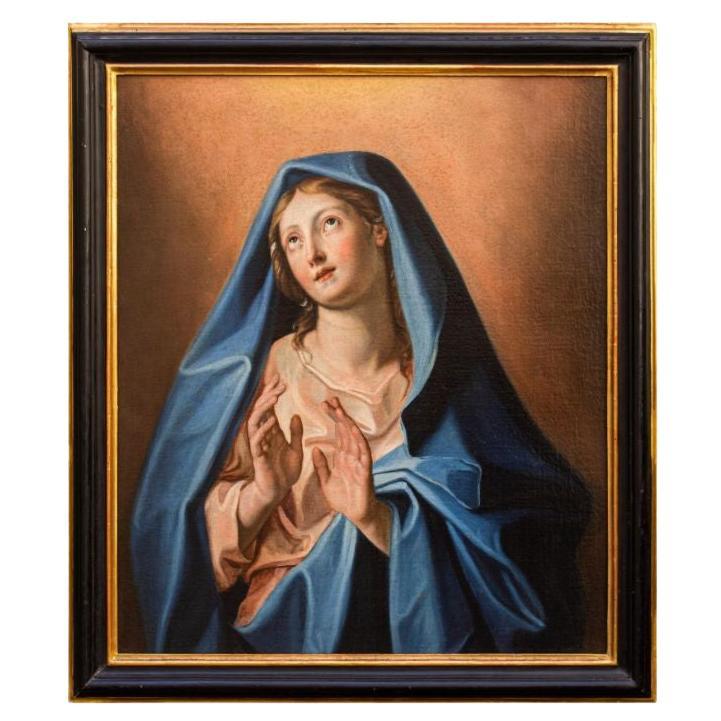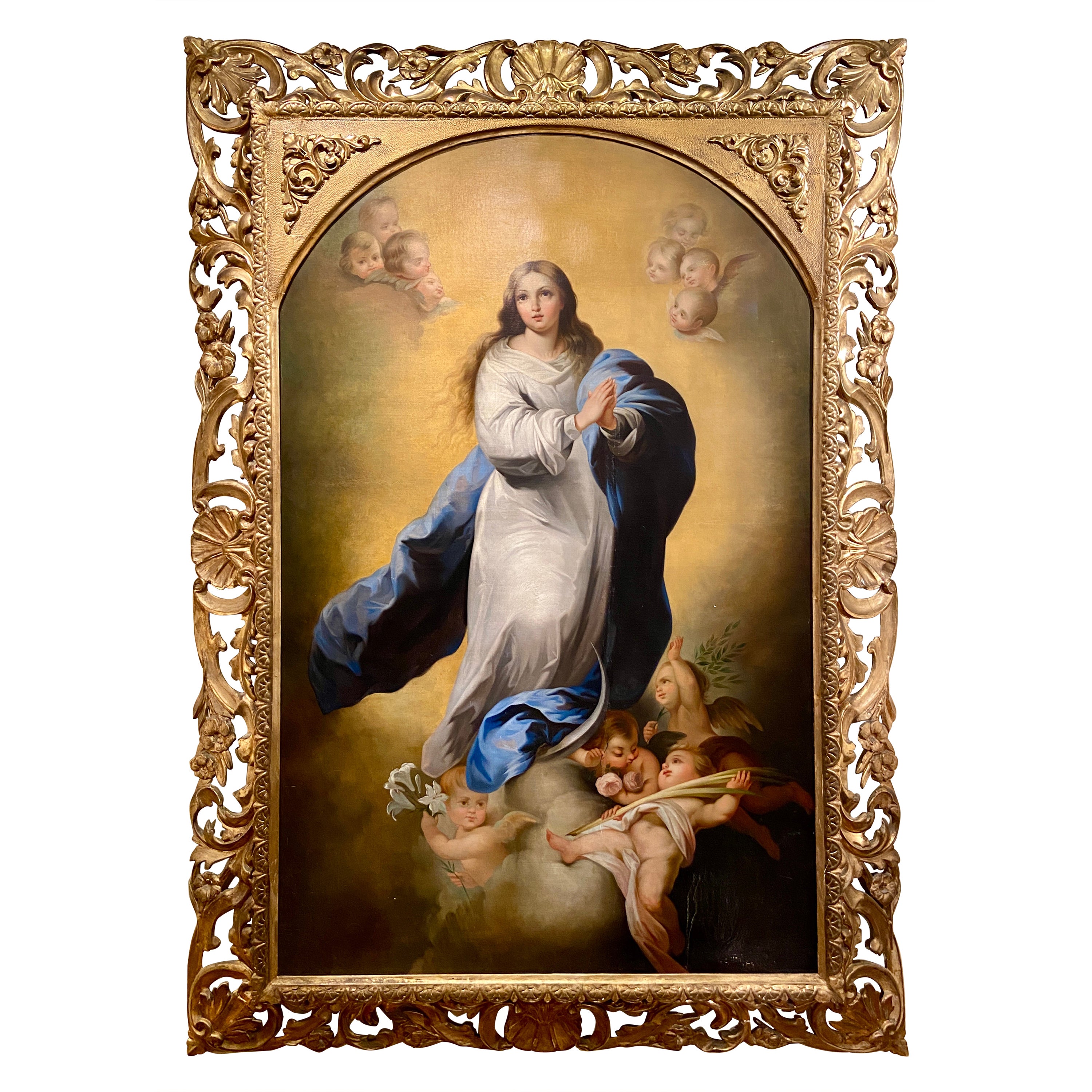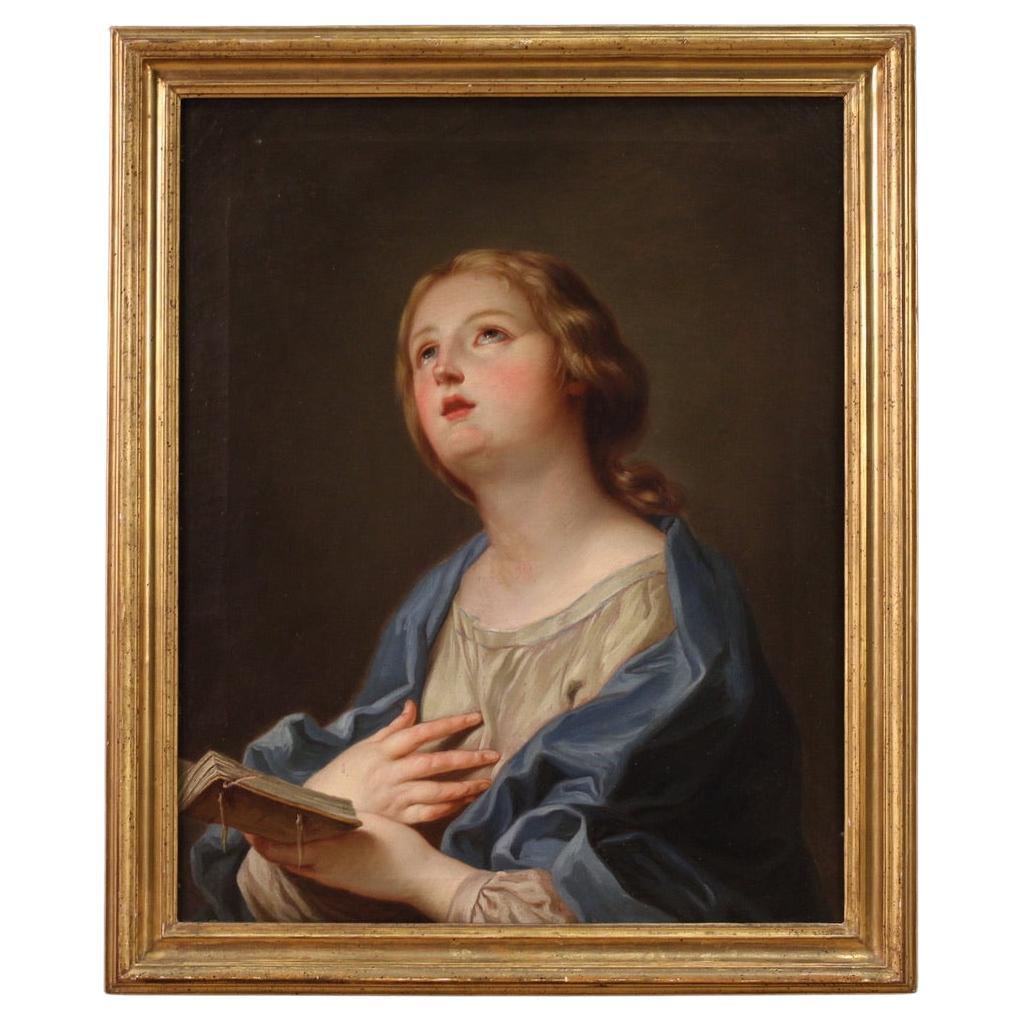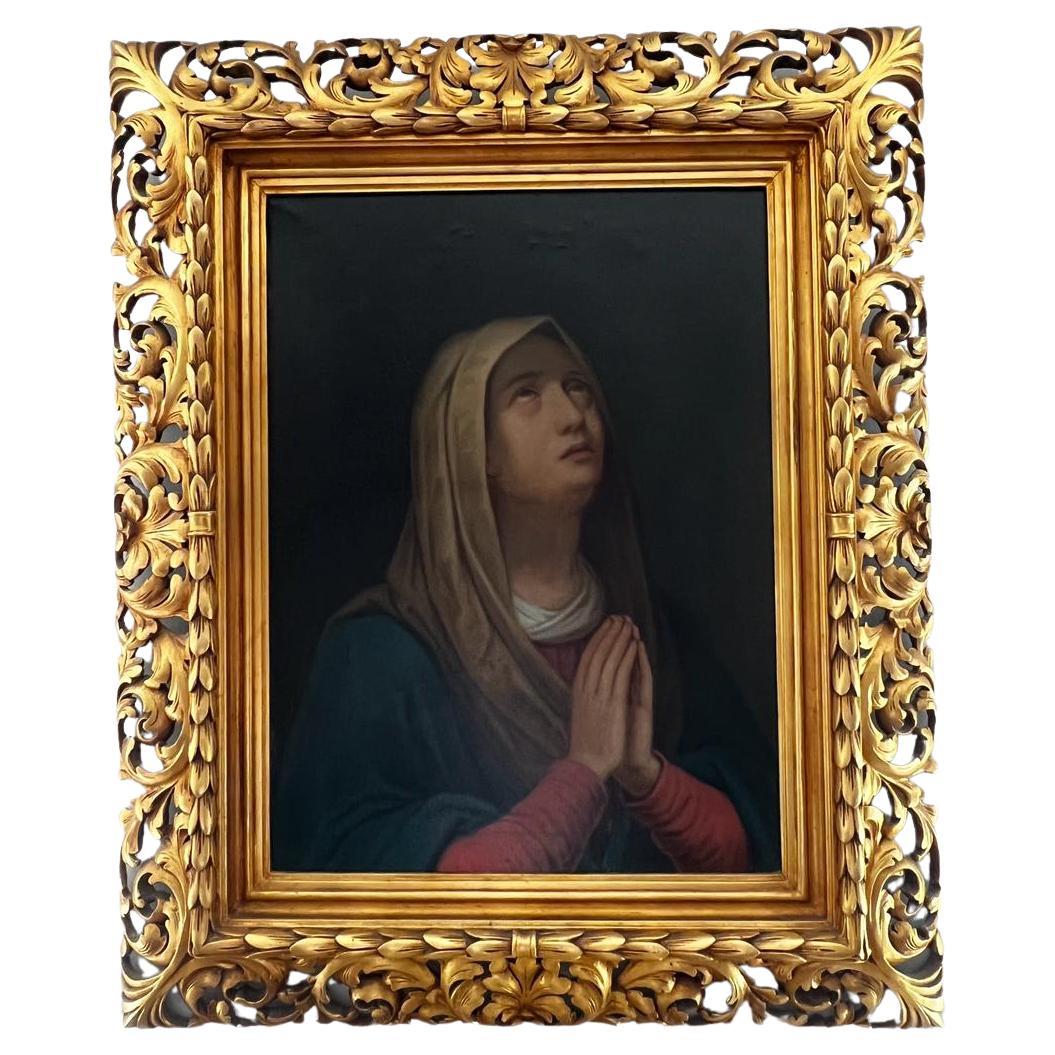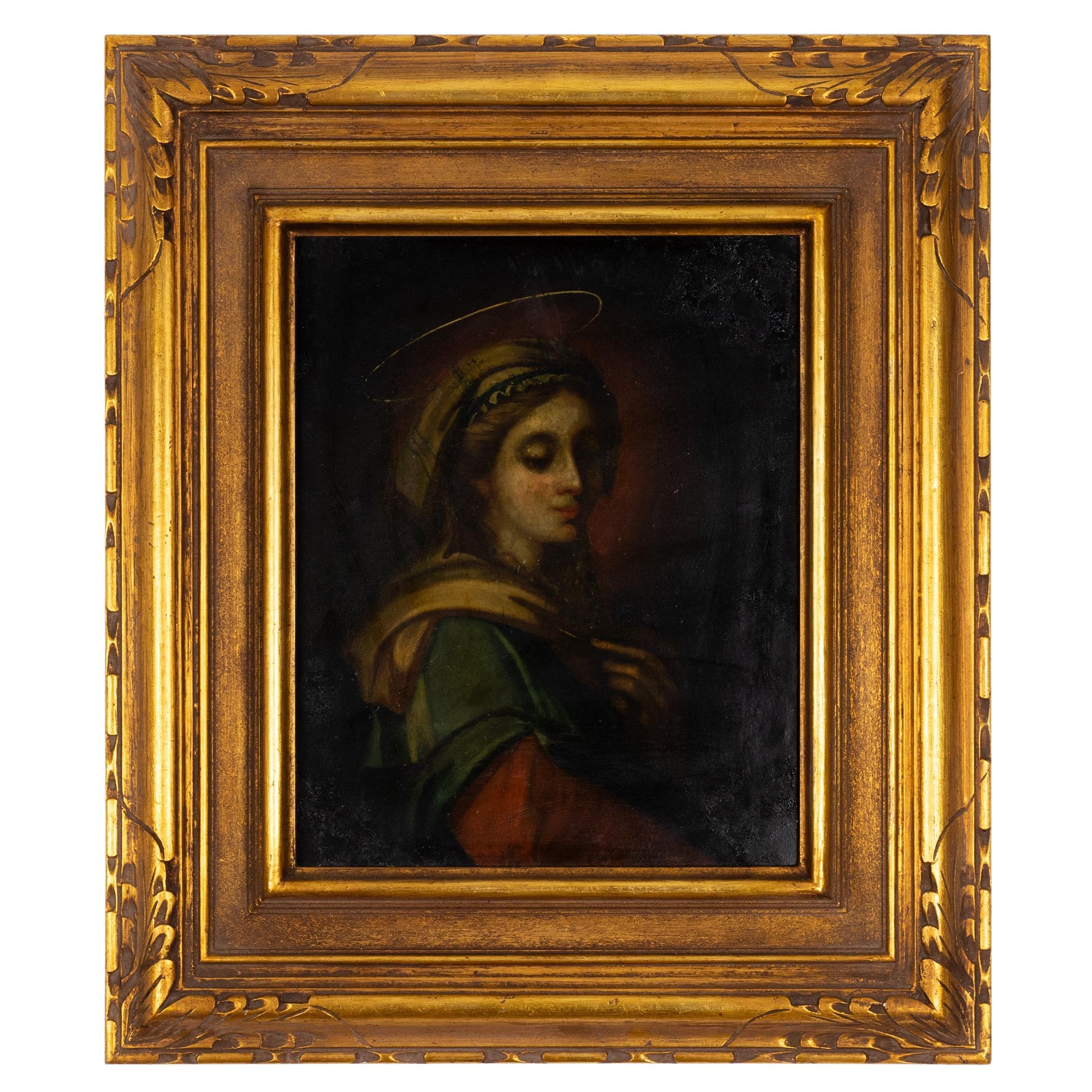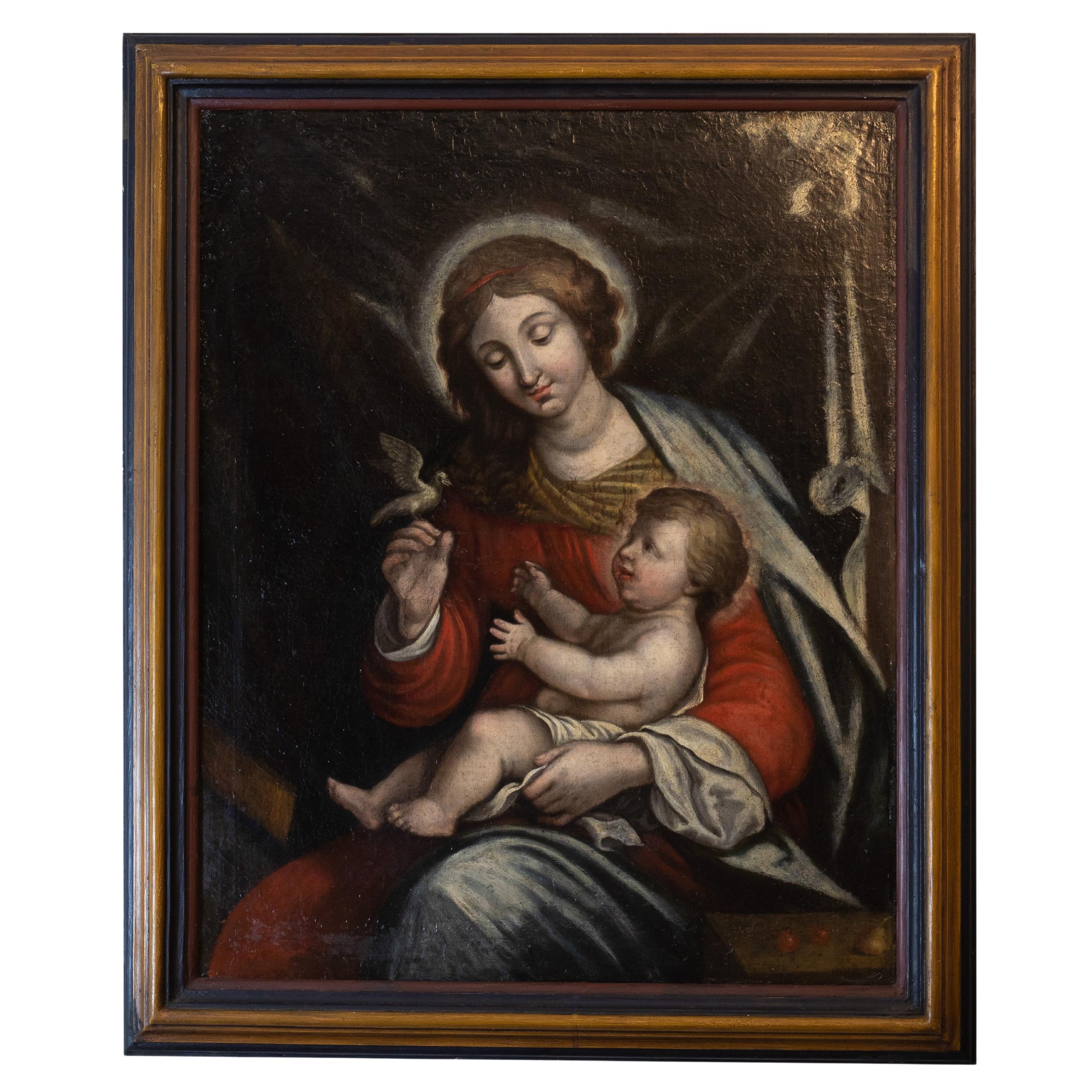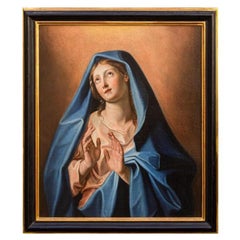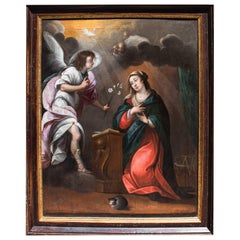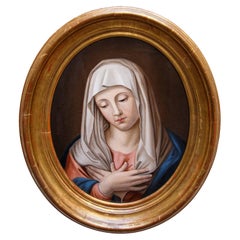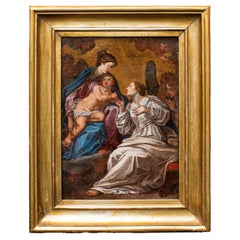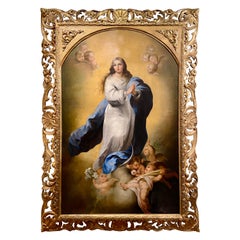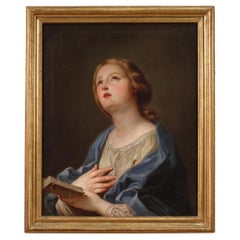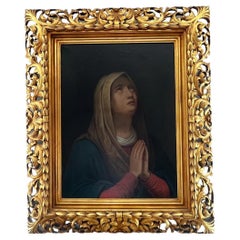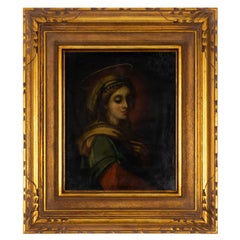Items Similar to 17th Century Virgin of the Assumption Painting Oil on Canvas
Want more images or videos?
Request additional images or videos from the seller
1 of 5
17th Century Virgin of the Assumption Painting Oil on Canvas
$2,619.06
£1,946.67
€2,200
CA$3,616.20
A$4,010.10
CHF 2,107.01
MX$48,996.61
NOK 26,361.57
SEK 24,744.84
DKK 16,751.90
About the Item
17th century
Virgin of the Assumption
Oil on canvas, 93 x 81 cm
Frame, 110 x 97 cm
The present Assumption of the Virgin welcomes an innovative part of the iconography typical of the dogma of the Immaculate Conception, that is the halo made up of twelve stars. The a posteriori juxtaposition and traditional resonance of this attribute to the figure of the Immaculate Conception (in the texts, this crown appears only in chapter 12 of the Apocalypse and in reference to the woman girded with the sun that St. John admires in vision) the crown itself does not uniquely signify the incorruptible purity but, more generally, the eternal essence of the Madonna in human and divine time. The lack, in the present work, of the attributes that are indeed certainly characterizing The Immaculate Conception, such as the trampled serpent and the moon or globe trodden by Mary,
The present painting is comparable to the lesson of the so-called seventeenth-century classicism of the central Italic area, even if a tactile iridescentism clears it of the stylistic and compositional constraints of this "current". It is impossible to ignore the figurative references to Guido Reni (Bologna, 1575 - ibid, 1642), really similar, or to the solid volumes of this pupil Giovanni Andrea Sirani (Bologna, 1610 - ibid, 1670).
A reflection on the teaching of the great Emilian early-century painting leads, in the present Assumption, to the use of a perfectly modern artistic lexicon, in which the exceptional wonder that the work arouses overwhelms any scholastic model.
- Dimensions:Height: 43.31 in (110 cm)Width: 38.19 in (97 cm)Depth: 1.97 in (5 cm)
- Materials and Techniques:
- Place of Origin:
- Period:
- Date of Manufacture:17th Century
- Condition:Refinished. Wear consistent with age and use. The painting has been cleaned.
- Seller Location:Milan, IT
- Reference Number:1stDibs: LU5918226541092
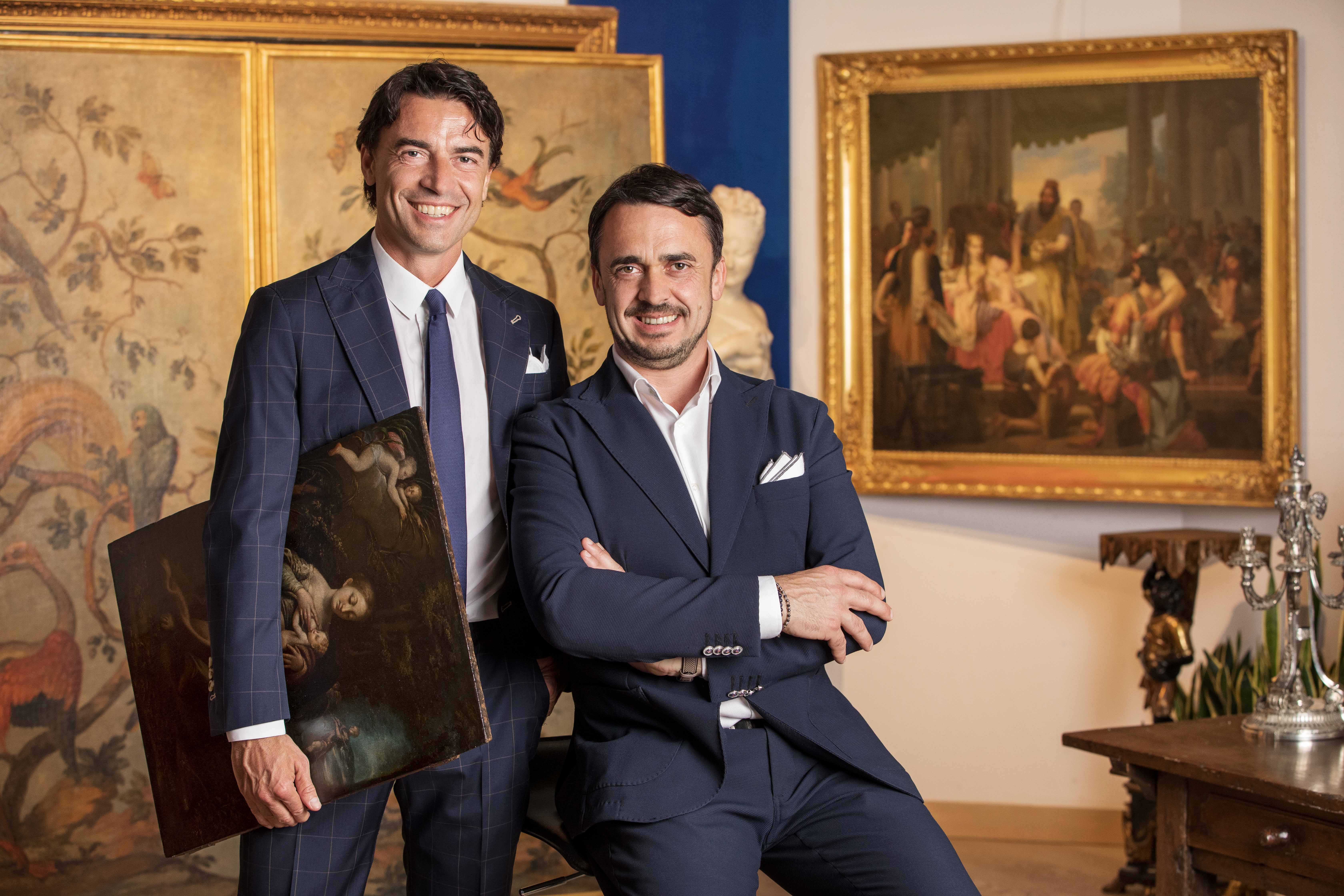
About the Seller
5.0
Vetted Professional Seller
Every seller passes strict standards for authenticity and reliability
Established in 2000
1stDibs seller since 2021
30 sales on 1stDibs
Typical response time: 1 to 2 days
- ShippingRetrieving quote...Shipping from: Milan, Italy
- Return Policy
Authenticity Guarantee
In the unlikely event there’s an issue with an item’s authenticity, contact us within 1 year for a full refund. DetailsMoney-Back Guarantee
If your item is not as described, is damaged in transit, or does not arrive, contact us within 7 days for a full refund. Details24-Hour Cancellation
You have a 24-hour grace period in which to reconsider your purchase, with no questions asked.Vetted Professional Sellers
Our world-class sellers must adhere to strict standards for service and quality, maintaining the integrity of our listings.Price-Match Guarantee
If you find that a seller listed the same item for a lower price elsewhere, we’ll match it.Trusted Global Delivery
Our best-in-class carrier network provides specialized shipping options worldwide, including custom delivery.More From This Seller
View AllEarly 17th Century Roman School Praying Madonna Painting Oil on Canvas
Located in Milan, IT
Roman school, late 16th-early 17th century Praying Madonna
Oil on canvas, 81 x 69 cm
Frame 83 x 95.5 cm
A divine whiteness reverberates with vibrant luster on the maphorion of the present Virgin. The palpable iridescence that structures the thin rosaceous garment, woven with the same fresh light, produces a slight rustle when she takes her hands off. The Madonna in fact takes a prayerful pose, opening her palms to underline her fervent ecstatic intention; the white neck is rendered with perishable fullness of pigments, like the hands, perfectly alive, and the very shiny eyes. With fine shrewdness the artist of the present styles the Virgin's hair with thin white ribbons, exacerbating the purity. An evocative light falls gently on the bust, a materialized sign of divine glory.
The present can be traced back to the late Mannerist climate that prevailed in the capital after the emanation of the Tridentine council (1545-1563). The late Mannerist licenses that can still be seen there, such as the intense lyricism in the stylistic code adopted by the artist, are innervated in the new basic catechetical intent, which at the end of the century produced a certain figurative rigorism. The present, however, still responds to that extraordinary Roman dynamism that raised the capital to a bulwark for the entire mannerist lesson, matched only by a second artistic center, the Florentine one. The engaging carriage of the Virgin reflects the contemporary examples of Giuseppe Valeriano (1542-1596), a Jesuit painter, returning in the Marriage of the Virgin of the Roman Church of Jesus, as well as in the Madonna of Sorrows in the Recanati Altarpiece, equal ardor. But it is in the Assumption of the Virgin painted in four hands with Scipione Pulzone...
Category
Antique Early 17th Century Italian Paintings
Materials
Canvas
17th Century Annunciation Painting Oil on Canvas Workshop of Nuvolone
Located in Milan, IT
17th century, Nuvolone workshop
Annunciation
Measures: Oil on canvas, 98.50 x 127.00 cm - with frame 144 x 115
Depicted is a canonical Annunciation which sees Mary on her knees ...
Category
Antique 17th Century Italian Paintings
Materials
Canvas
19th century, from Sassoferrato, Madonna Orante
Located in Milan, IT
19th century, by Giovanni Battista Salvi, known as Sassoferrato (Sassoferrato, 1609 - Rome, 1685)
Praying Madonna
Oil on canvas, 44 x 54 cm
Framed, 88 x 60 cm
Giovanni Battista S...
Category
Antique 19th Century Italian Other Paintings
Materials
Canvas
17th Century Mystical Marriage of Saint Catherine Oli on Canvas Roman School
Located in Milan, IT
17th century, Roman School
Mystical marriage of Saint Catherine of Alexandria
Oil on canvas, 32 x 23 cm
Frame cm 45 x 36
The saint is depicted in front of the Virgin holding the Child portrayed with the wedding ring in his hand, enriched with a precious stone. According to the Golden Legend, Catherine of Alexandria was a very beautiful young woman, the only daughter of the king of Costa, who had refused to marry the emperor Maxentius because she was a Christian and devoted to Christ. Maxentius, unable to convince her to sacrifice to idols, had sent to call the wisest men and fifty philosophers and orators who presented themselves and tried to divert her from faith in Christ. Catherine, however, played so well that she was able to convert them, arousing the anger of the emperor who condemned them to the stake. Catherine, however, who had criticized Maxentius for the new persecutions against the Christians, was sentenced to prison without food. Abandoned for twelve days, she was fed by a dove sent by God. Maxentius then decided to execute her with the torture of the toothed wheel become her attribute iconographic; but by divine intervention this broke and the young was saved. Finally, she was beheaded and milk flowed from her neck. Catherine’s princely status is witnessed here by her sumptuous dress. The iconography of the mystical marriage was born in the fifteenth century, probably because the traditional iconographic attribute, the wheel, was sometimes so small as to look like a ring, and refers to a vision that will always remain present in the mind and heart of the saint. In Heaven she appeared to her, among the Angels and Saints, Christ the Child, in the arms of the Virgin. He took a precious ring that the Virgin Mary handed to her and put it in her finger, saying "I, your Creator and Saviour, take you in marriage; confident that you will keep you pure until you celebrate your eternal wedding with me, in Paradise" When Catherine was laughing, she found in her finger the same ring that she had seen and had in Heaven, and she considered herself forever the bride of Christ.
In this extraordinary episode we can see the heart of Catherine’s religious sense, and of all her spirituality. For her, Christ is like the bridegroom, with whom there is a relationship of intimacy, communion and fidelity; he is the beloved, whom she loves above all...
Category
Antique 17th Century Italian Decorative Art
Materials
Canvas
17th Century Mystical Marriage of Saint Catherine Painting Oil on Canvas
Located in Milan, IT
17th century
Mystical marriage of Saint Catherine
Measures: Oil on canvas, 98 x 81 cm - with frame 119 x 102 cm
The scene represents the mystical marriage between Catherine of A...
Category
Antique 17th Century Italian Paintings
Materials
Canvas
16th Century Madonna of the Carnations Painting Oil on Canvas from Raffaello
By Raphael (Raffaello Sanzio da Urbino)
Located in Milan, IT
16th century, by Raffaello Sanzio (Urbino, 1483 - Rome, 1520)
Madonna of the Carnations
Measures: Oil on canvas 38 x 30 - with frame 59 x 52.5 cm
The Madonna dei Garofani made b...
Category
Antique 16th Century Italian Paintings
Materials
Canvas
You May Also Like
Antique 19th Century Oil on Canvas Painting of The Assumption in Original Frame
Located in New Orleans, LA
Exceptional size antique 19th century oil on canvas painting of The Assumption in original carved gold-leaf frame.
Category
Antique 19th Century Paintings
Materials
Canvas, Paint, Wood
19th Century Oil on Canvas Italian Antique Religious Painting Praying Madonna
Located in Vicoforte, Piedmont
Wonderful 19th century Italian painting. Oil painting on canvas, first canvas, depicting a splendid praying Madonna who takes as a model a late Baroque devotional composition, presum...
Category
Antique 1850s Italian Paintings
Materials
Canvas
Antique 18th Century Madonna in Sorrow Oil on Canvas, Florentine School
Located in Doha, QA
This antique stunning portrait of Madonna in Sorrow came out from a Palazzo in Florence and an absolute eye catcher. The colors and details are incredible and very typical for an Ita...
Category
Antique Late 18th Century Italian Baroque Paintings
Materials
Canvas
Baroque Religious Painting Of Immaculate Conception, Gilt Frame, 17th Century
Located in Lisbon, PT
This 17th-century Baroque painting, in oil on copper, captures a serene portrayal of the Immaculate Conception, draped in yellow silk robes with accents of green and red. The divine ...
Category
Antique 17th Century Italian Renaissance Paintings
Materials
Copper
$6,408 Sale Price
23% Off
Our Lady of Peace Italian Renaissance Religious Painting, 18th Century
Located in Lisbon, PT
An 18th-century Italian Renaissance oil painting of Our Lady of Peace, depicting Mary in red and green robes holding the Christ Child and a white dove. Against a dark, atmospheric ba...
Category
Antique 18th Century Italian Renaissance Paintings
Materials
Canvas
$23,619 Sale Price
39% Off
Antique 17th Century Painting Madonna /Virgin Mary Italy Oil on Canvas
Located in Doha, QA
Magnificent Italian 17th century Portrait of Virgin Mary measures 52 x 68 cm without the frame.
The colors are stunning and the paintin...
Category
Antique 17th Century Italian Baroque Paintings
Materials
Canvas
More Ways To Browse
Sun Moon Stars
Immaculate Conception
Giovanni Bologna
Poul Ekelund
Poul Steffensen
Puerto Rican Artist
R Monti Art
Rainey Bennett
Robert Mcgregor
Roybal Painting
Russian Icon George Slaying
Serge Belloni Painting
Serge Belloni
Severin Roesen
Sir William Russell Flint
Squirrel Man Furniture
Stephanie Hoppen
Steve Burgess
